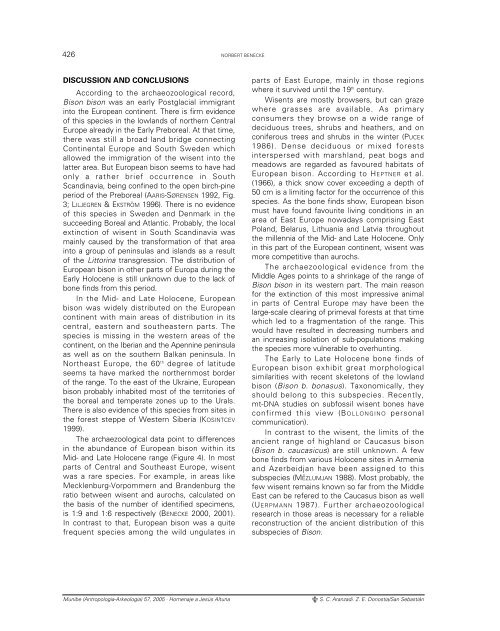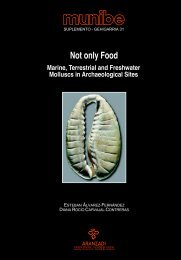The Holocene distribution of European bison – the ... - Aranzadi
The Holocene distribution of European bison – the ... - Aranzadi
The Holocene distribution of European bison – the ... - Aranzadi
You also want an ePaper? Increase the reach of your titles
YUMPU automatically turns print PDFs into web optimized ePapers that Google loves.
426 NORBERT BENECKE<br />
DISCUSSION AND CONCLUSIONS<br />
According to <strong>the</strong> archaeozoological record,<br />
Bison <strong>bison</strong> was an early Postglacial immigrant<br />
into <strong>the</strong> <strong>European</strong> continent. <strong>The</strong>re is firm evidence<br />
<strong>of</strong> this species in <strong>the</strong> lowlands <strong>of</strong> nor<strong>the</strong>rn Central<br />
Europe already in <strong>the</strong> Early Preboreal. At that time,<br />
<strong>the</strong>re was still a broad land bridge connecting<br />
Continental Europe and South Sweden which<br />
allowed <strong>the</strong> immigration <strong>of</strong> <strong>the</strong> wisent into <strong>the</strong><br />
latter area. But <strong>European</strong> <strong>bison</strong> seems to have had<br />
only a ra<strong>the</strong>r brief occurrence in South<br />
Scandinavia, being confined to <strong>the</strong> open birch-pine<br />
period <strong>of</strong> <strong>the</strong> Preboreal (AARIS-SØRENSEN 1992, Fig.<br />
3; LILJEGREN & EKSTRÖM 1996). <strong>The</strong>re is no evidence<br />
<strong>of</strong> this species in Sweden and Denmark in <strong>the</strong><br />
succeeding Boreal and Atlantic. Probably, <strong>the</strong> local<br />
extinction <strong>of</strong> wisent in South Scandinavia was<br />
mainly caused by <strong>the</strong> transformation <strong>of</strong> that area<br />
into a group <strong>of</strong> peninsulas and islands as a result<br />
<strong>of</strong> <strong>the</strong> Littorina transgression. <strong>The</strong> <strong>distribution</strong> <strong>of</strong><br />
<strong>European</strong> <strong>bison</strong> in o<strong>the</strong>r parts <strong>of</strong> Europa during <strong>the</strong><br />
Early <strong>Holocene</strong> is still unknown due to <strong>the</strong> lack <strong>of</strong><br />
bone finds from this period.<br />
In <strong>the</strong> Mid- and Late <strong>Holocene</strong>, <strong>European</strong><br />
<strong>bison</strong> was widely distributed on <strong>the</strong> <strong>European</strong><br />
continent with main areas <strong>of</strong> <strong>distribution</strong> in its<br />
central, eastern and sou<strong>the</strong>astern parts. <strong>The</strong><br />
species is missing in <strong>the</strong> western areas <strong>of</strong> <strong>the</strong><br />
continent, on <strong>the</strong> Iberian and <strong>the</strong> Apennine peninsula<br />
as well as on <strong>the</strong> sou<strong>the</strong>rn Balkan peninsula. In<br />
Nor<strong>the</strong>ast Europe, <strong>the</strong> 60 th degree <strong>of</strong> latitude<br />
seems ta have marked <strong>the</strong> nor<strong>the</strong>rnmost border<br />
<strong>of</strong> <strong>the</strong> range. To <strong>the</strong> east <strong>of</strong> <strong>the</strong> Ukraine, <strong>European</strong><br />
<strong>bison</strong> probably inhabited most <strong>of</strong> <strong>the</strong> territories <strong>of</strong><br />
<strong>the</strong> boreal and temperate zones up to <strong>the</strong> Urals.<br />
<strong>The</strong>re is also evidence <strong>of</strong> this species from sites in<br />
<strong>the</strong> forest steppe <strong>of</strong> Western Siberia (KOSINTCEV<br />
1999).<br />
<strong>The</strong> archaezoological data point to differences<br />
in <strong>the</strong> abundance <strong>of</strong> <strong>European</strong> <strong>bison</strong> within its<br />
Mid- and Late <strong>Holocene</strong> range (Figure 4). In most<br />
parts <strong>of</strong> Central and Sou<strong>the</strong>ast Europe, wisent<br />
was a rare species. For example, in areas like<br />
Mecklenburg-Vorpommern and Brandenburg <strong>the</strong><br />
ratio between wisent and aurochs, calculated on<br />
<strong>the</strong> basis <strong>of</strong> <strong>the</strong> number <strong>of</strong> identified specimens,<br />
is 1:9 and 1:6 respectively (BENECKE 2000, 2001).<br />
In contrast to that, <strong>European</strong> <strong>bison</strong> was a quite<br />
frequent species among <strong>the</strong> wild ungulates in<br />
parts <strong>of</strong> East Europe, mainly in those regions<br />
where it survived until <strong>the</strong> 19 th century.<br />
Wisents are mostly browsers, but can graze<br />
where grasses are available. As primary<br />
consumers <strong>the</strong>y browse on a wide range <strong>of</strong><br />
deciduous trees, shrubs and hea<strong>the</strong>rs, and on<br />
coniferous trees and shrubs in <strong>the</strong> winter (PUCEK<br />
1986). Dense deciduous or mixed forests<br />
interspersed with marshland, peat bogs and<br />
meadows are regarded as favoured habitats <strong>of</strong><br />
<strong>European</strong> <strong>bison</strong>. According to HEPTNER et al.<br />
(1966), a thick snow cover exceeding a depth <strong>of</strong><br />
50 cm is a limiting factor for <strong>the</strong> occurrence <strong>of</strong> this<br />
species. As <strong>the</strong> bone finds show, <strong>European</strong> <strong>bison</strong><br />
must have found favourite living conditions in an<br />
area <strong>of</strong> East Europe nowadays comprising East<br />
Poland, Belarus, Lithuania and Latvia throughout<br />
<strong>the</strong> millennia <strong>of</strong> <strong>the</strong> Mid- and Late <strong>Holocene</strong>. Only<br />
in this part <strong>of</strong> <strong>the</strong> <strong>European</strong> continent, wisent was<br />
more competitive than aurochs.<br />
<strong>The</strong> archaezoological evidence from <strong>the</strong><br />
Middle Ages points to a shrinkage <strong>of</strong> <strong>the</strong> range <strong>of</strong><br />
Bison <strong>bison</strong> in its western part. <strong>The</strong> main reason<br />
for <strong>the</strong> extinction <strong>of</strong> this most impressive animal<br />
in parts <strong>of</strong> Central Europe may have been <strong>the</strong><br />
large-scale clearing <strong>of</strong> primeval forests at that time<br />
which led to a fragmentation <strong>of</strong> <strong>the</strong> range. This<br />
would have resulted in decreasing numbers and<br />
an increasing isolation <strong>of</strong> sub-populations making<br />
<strong>the</strong> species more vulnerable to overhunting.<br />
<strong>The</strong> Early to Late <strong>Holocene</strong> bone finds <strong>of</strong><br />
<strong>European</strong> <strong>bison</strong> exhibit great morphological<br />
similarities with recent skeletons <strong>of</strong> <strong>the</strong> lowland<br />
<strong>bison</strong> (Bison b. bonasus). Taxonomically, <strong>the</strong>y<br />
should belong to this subspecies. Recently,<br />
mt-DNA studies on subfossil wisent bones have<br />
confirmed this view (BOLLONGINO personal<br />
communication).<br />
In contrast to <strong>the</strong> wisent, <strong>the</strong> limits <strong>of</strong> <strong>the</strong><br />
ancient range <strong>of</strong> highland or Caucasus <strong>bison</strong><br />
(Bison b. caucasicus) are still unknown. A few<br />
bone finds from various <strong>Holocene</strong> sites in Armenia<br />
and Azerbeidjan have been assigned to this<br />
subspecies (MEZLUMJAN ˇ 1988). Most probably, <strong>the</strong><br />
few wisent remains known so far from <strong>the</strong> Middle<br />
East can be refered to <strong>the</strong> Caucasus <strong>bison</strong> as well<br />
(UERPMANN 1987). Fur<strong>the</strong>r archaeozoological<br />
research in those areas is necessary for a reliable<br />
reconstruction <strong>of</strong> <strong>the</strong> ancient <strong>distribution</strong> <strong>of</strong> this<br />
subspecies <strong>of</strong> Bison.<br />
Munibe (Antropologia-Arkeologia) 57, 2005 · Homenaje a Jesús Altuna<br />
S. C. <strong>Aranzadi</strong>. Z. E. Donostia/San Sebastián
















